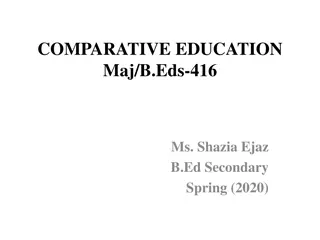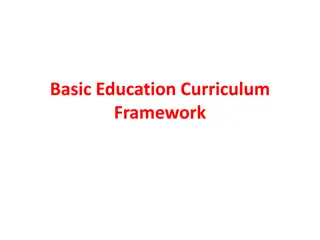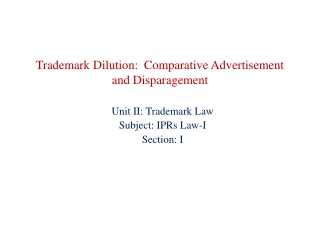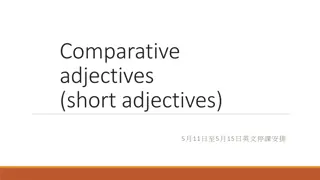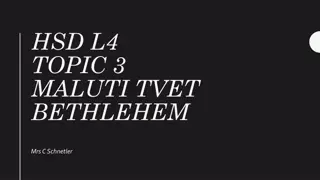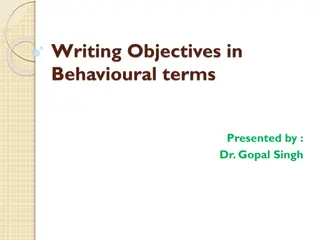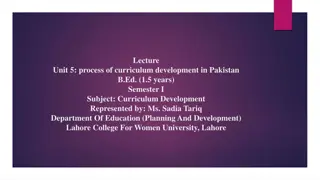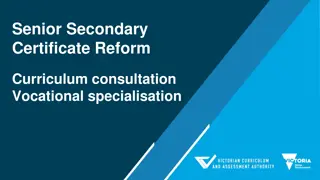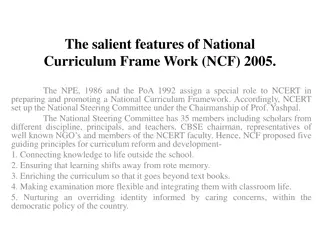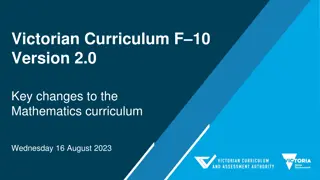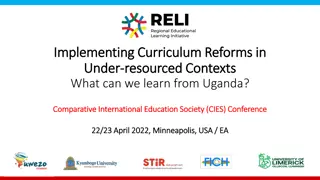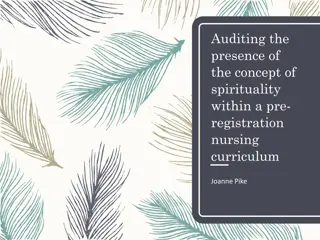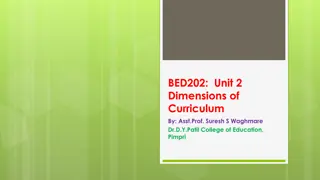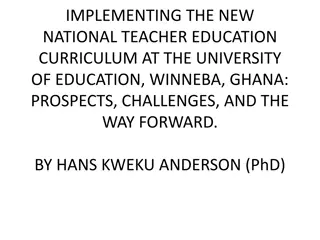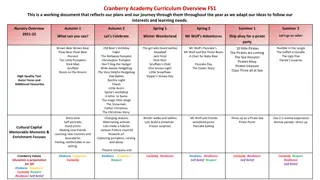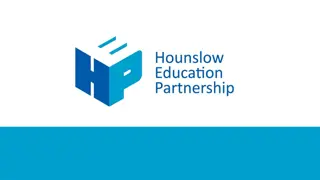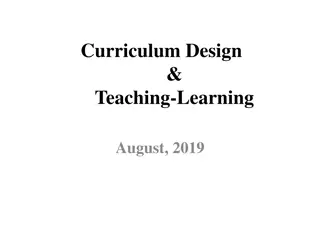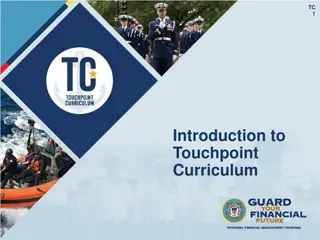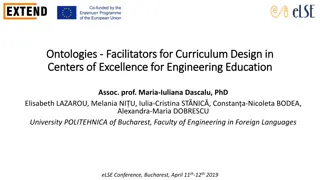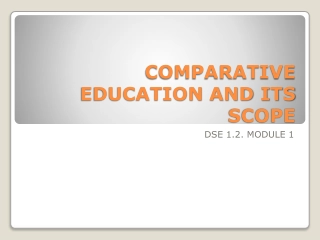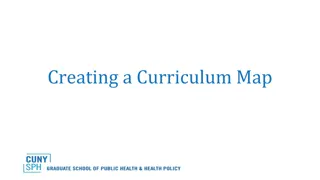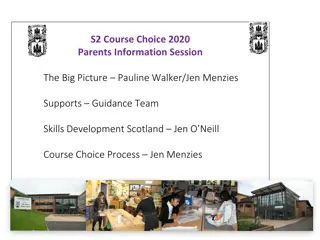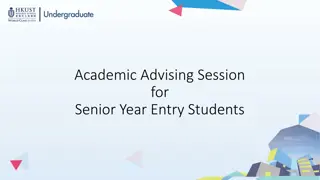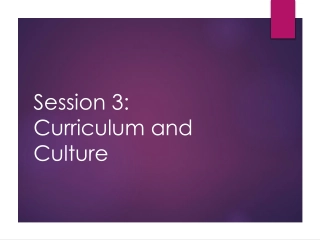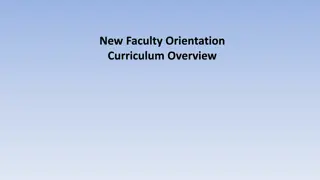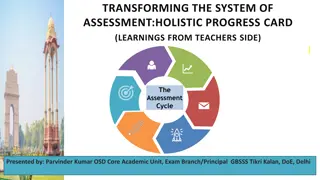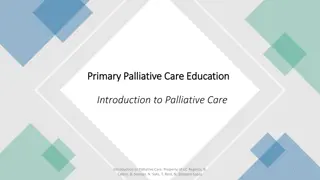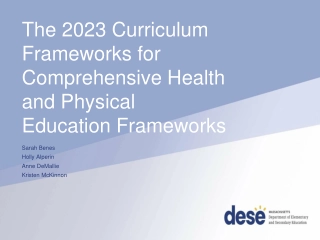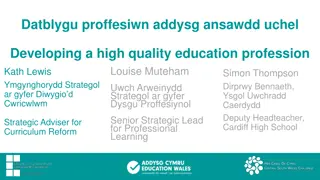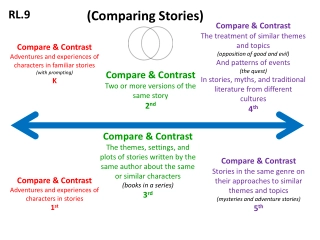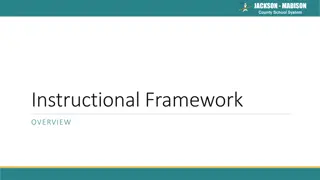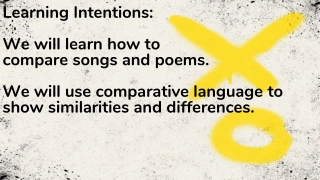Comparative Education Objectives and Curriculum Overview
Comparative education aims to describe, develop, and establish relationships between educational systems and societies across countries. It seeks to regulate education aspects, facilitate reform, and promote international cooperation. The curriculum is defined as the total student experiences within the education process, encompassing planned instructional sequences and learning goals.
Download Presentation

Please find below an Image/Link to download the presentation.
The content on the website is provided AS IS for your information and personal use only. It may not be sold, licensed, or shared on other websites without obtaining consent from the author. Download presentation by click this link. If you encounter any issues during the download, it is possible that the publisher has removed the file from their server.
E N D
Presentation Transcript
UNIT 2 Elements of Comparative Education (Both Qualitative and Quantitative)
Objectives of comparative Education According to Harold Noah (1985), and Dr. Farooq Joubish (2009), comparative education has four objectives: 1. To describe educational systems, processes, or outcomes. 2. To assist in the development of educational institutions and practices. 3. To highlight the relationships between education and society. 4. To establish generalized statements about education that are valid in more than one country
CONT In addition to these objectives, some of the general objectives of Comparative Education 1. To provide a picture or profile of the education systems in various countries or regions of the world. 2. To enable one come up with a global description and classification of education in various parts of the world.
CONT 3. To regulate the relations and aspects in education and society, for example, how does family size affect education? How does social status affect education? Or what are the motivations of different social classes to participate in education? 4. To distinguish the fundamental elements of educational persistence and change and relate these with philosophical laws.
CONT 5. To facilitate practical reform and planned development of the school system, that is, improvement of education at home. In order to achieve this aims one requires to establish the correlation of aims, customs, social norms and the education system. 6. To enable one have a greater understanding of the wider educational process. 7. To promote the spirit of international understanding and co-operation among those who study it, by promoting friendship, understanding other people's points of view and appreciate other people's cultures.
Curricula In education, a curriculum is broadly defined as the whole of student experiences that happen in the educational process. The term often refers specifically to a planned sequence of instruction, or to a view of the student's experiences in terms of the educator's or school's instructional goals. In a 2003 study Reys, Reys, Lapan, Holliday and Wasman refer to curriculum as a set of learning goals articulated across grades that outline the intended mathematics content and process goals at particular points in time throughout the K 12 school program.
CONT Curriculum may incorporate the planned interaction of learners with instructional content, materials, resources, and processes for assessing the achievement of educational objectives. Curriculum is divided into several categories, the clear, the understood (including the hidden), the excepted and the extra-curricular. Curricula may be tightly standardized, or may include a high level of instructor or learner self-sufficiency. Many countries have national curricula in primary and secondary education, such as the United Kingdom's National Curriculum. UNESCO's International Bureau of Education has the primary mission of studying curricula and their implementation worldwide.
Assessment (students achievement examination system) Examination is a assessing instrument intended to verify both a candidates value and value of teaching he has received. It is an indicator of the training given and received. It is to measure what has been accomplished during the period of study to consider each candidate s sum of knowledge and assess his ability. It looks like target, incentive.
CONT At current, 3 types of examination systems are being used in Pakistan: semester without external assessment, semester with external assessment, and annual with external assessment. The first is being practiced in all private and few public sector institutions, whereas the latter 2 are in use in most of the public sector and a few private institutes affiliated with public-sector universities.
Examination Terminal or Annual examinations are held at the end of the middle and secondary education and is totally external. At secondary and higher secondary level, students are also inspected at the end of 2 years course by Boards of Intermediate and Secondary Education (BISEs). For university degree, examination is held by the universities. These examinationsare semesterwise as well as annually. held
Teaching Methods Lecture Method: Lecture method is most convenient and inexpensive method of teaching any subject. It hardly requires the use of scientific apparatus, experiment, and aids materials except for the black board. Lecture method is teacher controlled and information centered approach in which teacher works as a role resource in classroom instruction. In this method, the only teacher does the talking and the student is passive listeners.
CONT In the field of education, lecture method is used very frequently. This method is used in order to gain knowledge and concept. Lecture method mainly focuses on cognitive objectives. The main emphasis of this approach is the demonstration of the content. In this method teachers plans and controls the whole teaching learning process. To make the lecture interesting, the teacher can take the help of audio -visual aids.
Principles of lecture method (1) A student can learn better through listening. (2) Through lecture method, the teacher makes an attempt to convey perfect and complete knowledge of the subject or the topic students. (3) Subject matter can be correlated with other subjects. (4) New knowledge is given related to previous knowledge.
When to use lecture method (1) It is used to give an overview of a large unit (2) This method is an effective way for motivating learners and increasing their interest in the subject. (3) It is used for supplementing the learners reading and for clarifying main concepts. (4) This method helps to save the time of students by providing important information in short time period. (5) This method is used to provide background.
Steps of the lecture method (1) Preparation for the lecture:- This includes silent points like (a) suitable language and manner of performance according to the nature of students. (b) selection of audio-visual aids and instructional materials. (c) planning the motivational technique (d) anticipating certain difficulties and problem during the lecture.
CONT (2) Introduction to the lecture:- It should be done briefly and if it is performed poorly, it can initially kill off the interest of the student. (3) Giving the body of the lecture:- The teacher should have a given cognitive framework upon which he relies to achieve a more logical presentation.
Advantage of lecture method (1) It is economical with regard to time. (2) It helps in developing the habit of concentration among the students. (3) It helps in achieving even high order cognitive objectives ( i.e ) application, analysis. ( (5) It develops good audience habits. (6) Through this method, new subject matter can easily be introduced. (7) It enables linkage between previous knowledge with a new one.
Disadvantages of lecture method (1) Since this is a teacher-centered method so it provides very little scope for student activity. (2) Student plays a passive role in this method. (3) Individual differences are not taken into consideration. (4) It can not be used for achieving psycho motor objectives.
Demonstration Method Demonstration method of teaching is a traditional classroom approach used in technical and training colleges and in teacher education. Demonstration is a teaching method used to communicate an idea with the aid of visuals such as flip charts, posters, power point. A demonstration is the process of teaching someone how to make or do something in a step- by-step process. As you show how, you tell what you are doing.
Focus and Structure Demonstration Approach focus to achieve psychomotor and cognitive objectives. If we talk about its structure, it is given in three consecutive steps: Introduction: In this step objectives of the lesson are identified. The teacher may be called demonstrator. He demonstrates the activity before the student that is to be established. Development. Students try to initiate the demonstrated activity. If there is any query the teacher tries to satisfy them by further demonstration and pictures. Integration. At this step, the teacher integrates all the activities and then these activities are prepared revised and assessed.
Principles This teaching approach is based on the following principles Learning by doing maxim is followed Skills can be developed by limitation The perception helps in imitation
Advantages It helps in involving various sense to make learning permanent Teacher behavior is autocratic, he invites the cooperation of learners in teaching learning process It develops interest in the learners and motivates them for their active participation It helps in achieving psychomotor objectives
Disadvantages It can be used only for skills subjects Only the attention of the learners is invited towards the activity demonstrated. Due to poor economic conditions of the government schools, there is shortage of audio-visual aids and tools and the teachers are not so creative to produce handmade models for demonstration. There is a general lack of sincerity and carefulness among teachers who wish to complete the syllabus at the earliest without putting sincere efforts.
Discussion Method Discussion involves two-way communication between participants. In the classroom situation an instructor and trainees all participate in discussion. During discussion, the instructor spends some time listening while the trainees spend sometimes talking. The discussion is, therefore, a more active learning experience for the trainees than the lecture.
CONT A discussion is the means by which people share experiences, ideas and attitudes. As it helps to trainees involvement in what they are learning, it may contribute to desired attitudinal changes. Discussion may be used in the classroom for the purpose of lesson development, making trainees apply what they have learnt or to monitor trainees learning by way of feedback.
LESSON DEVELOPMENT In parts in which trainees already have some knowledge or experience, discussion may be used to develop the main points to be covered in a lesson. For example, in safety training many of the procedures and behaviour that should be observed can be established through discussion with trainees. Trainees can draw on their experience of working in workshops contract sites to contribute to the discussion. In discussing some issues, differences of opinion arise. The discussion can help to clarify the different points of view and may assist each trainee to define his or her own opinion. Used in this way, discussion may be more effective in motivating trainees than lectures. Trainees can see that some importance is attached to their contributions.
APPLICATION Discussion may also be used, following a lecture or demonstration, to help trainees apply what they have learned. . For example following a lecture on types of wood joint , the instructor may, lead a discussion directing trainees attention to the places or pieces of furniture where each type is found, and the reasons for using one type than the other. Used in this way discussion contributes to the transfer of learning.
FEEDBACK The discussion method also provides an opportunity to monitor trainees learning. The answers provided by trainees and the questions they ask, reveal the extent and quality of learning taking place. Instructors can use this information to repeat or modify an explanation to improve learning. . Discussion used in this way should follow after other methods of classroom instruction such as lectures, demonstration or practice sessions.
CONDUCTING A DISCUSSION Discussion sessions can be led by the instructor, or can take place in groups. In either case, the goal is to meet the lesson objectives by allowing the trainees to:- a) Relate relevant personal experiences or events which have happened in the work setting. b) Contribute ideas or personal opinions. c) Apply what has been learned to familiar situations or solving problems. d) Express what had been learned. The discussion is instructor led or takes place in groups it must be guided by the instructor. It must be focused on the objectives of the lesson: it is the instructors responsibility to see that the objectives are met.
Educational Structure Progression and Stages of Education Pre-Primary Stage Elementary Education (Primary and Middle) Primary stage(class I-V) Middle stage (classVI-VIII) Secondary stage ( Class IX-X) Higher secondary stage (Class IX_XII)
CONT Higher Education (after class XII) universities and degree awarding institutions
CONT Vocational Education Technical Education Commerce/ Business Education Agricultural Education Medical Education Engineering Non-Formal Education
CONT Kinds of Institutions 1.Government Institutions 2.Federal Government Institutions 3.Garrison Institutes 4.Cadet Schools & Colleges 5.Local Bodies Institutions 6.Public SectorInstitutions
CONT 7. DanishSchools 8. Private Elite & 9.Non-Elite English Medium Schools 10.Madrassahs 11.Missionary Schools
Curriculum Class (I-XII) Formulation and ResponsibleAuthority NBCT in collaboration with; Department of Education Curriculum Research and Development Centers Education Extensions Centers Textbook Boards Teachers TrainingInstitutions Board Examination Universities
CONT Procedure of Curriculum Development and Implementation Initial drafts of curricula are prepared by the Provincial Curriculum Centers then sent to the CurriculumWing. A National Committee representing all the provinces is constituted. and
CONT The committee develops one draft Curriculum which is then sent to provinces for comments. Micro-testing of the curricula is carried out by the provinces. Final curriculum is developed by the National Committee and is implemented throughout the country.
Higher Education Curriculum Concerned departments of the universities or colleges. The title of courses and broader framework are usually discussed in the faculty, and then Each teacher plans in his/her own way to impart instructions in the classrooms.
Meaning and Nature of Teacher Education The National Council for Teacher Education has defined teacher education as A program of education, research and training of persons to teach from pre-primary to higher education level. Teacher education is a program that is related to the development of teacher skill and competence that would enable and empower the teacher to meet the requirements of the profession and face the challenges.
CONT According to Goods Dictionary of Education Teacher education means, all the formal and non-formal activities and experiences that help to qualify a person to assume responsibilities of a member of the educational profession or to discharge his responsibilities more effectively.
CONT Teacher education includes teaching skills, sound pedagogical theory and professional skills. Teaching skills would include providing training and practice in the different techniques, approaches and policies that would help the teachers to plan and communicate instruction and conduct effective assessment.
CONT It includes effective classroom supervision skills, preparation and use of instructional materials and communication skills. Pedagogical theory includes the philosophical and sociological considerations that would enable the teachers to have a sound basis for practicing the teaching skills in the classroom. The theory is stage specific and is based on the needs and requirements that are characteristic of that stage.
CONT Professional skills include the techniques, policies and approaches that would help teachers to grow in the profession and also work towards the growth of the profession. It includes soft skills, counseling skills, interpersonal skills, computer skills, information saving and supervision skills and above all life long learning skills.
Nature of Teacher Education : 1) Teacher education is a continuous process and its pre-service and in-service components are complimentary to each other. According to the International Encyclopedia of Teaching and Teacher education (1987),Teacher education can be considered in three phases : Pre-service, Induction and In-service. 2 The three phases are considered as parts of a continuous process. Teacher education is based on the theory that Teachers are made, not born in contrary to the assumption, Teachers are born, not made.
CONT 3) Teacher education is broad and comprehensive. Besides pre-service and in- service programs for teachers, it is meant to be involved in various community programs and extension activities, adult education and non- formal education programs, literacy and development activities of the society. 4) It is ever-evolving and dynamic. In order to prepare teachers who are competent to face the challenges of the dynamic society, Teacher education has to keep well-informed of recent developments and trends.
CONT 5) The root of the entire process of teacher education lies in its curriculum, design, structure, organization and transaction methods, as well as the extent of its relevance. 6) As in other professional education programs the teacher education curriculum has a knowledge base which is sensitive to the needs of field applications and comprises meaningful, conceptual blending of theoretical understanding available in several cognate disciplines.
CONT 7) Teacher education has become distinguished into stage-specific programs. This suggests that the knowledge base is effectively specialized and expanded across stages, which should be utilized for developing effective processes of preparing applicant teachers for the functions which a teacher is expected to perform at each stage. 8) It is a system that involves an interdependence of its Inputs, Processes and Outputs.
Scope of Teacher Education : The scope of teacher education can be understood in the following ways; Teacher education at different levels of education Aspects of teacher education
Administration Administration is a branch of university or college employees responsible for the maintenance and supervision of the institution and separate from the faculty or academics, although some personnel may have joint responsibilities. Some type of separate administrative structure exists at almost all academic institutions, some schools are governed by employees who are also involved in academic or educated work. Many senior administrators are academics who have advanced degrees and no longer teach or conduct research actively.
Administration organization Each province is divided into administrative divisions, Each division into districts, Each districts into Tehsil Each Tehsil into Union council.



